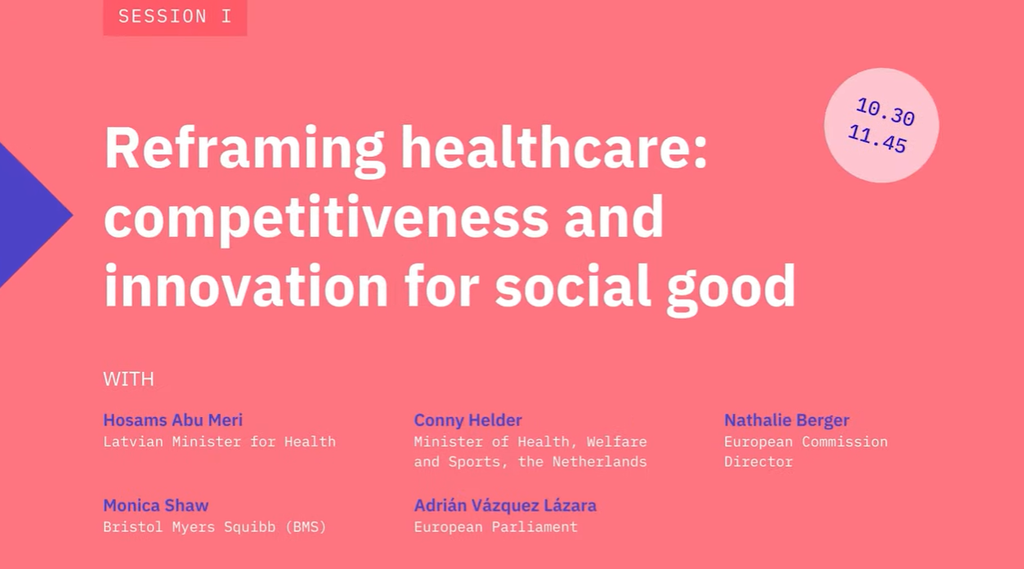Europe's moment: advancing clinical research and health innovation
Next event In person & online

- Area of Expertise
- Sustainable Livelihoods
Sustainable Livelihoods

Director of Innovation, European Institute of Innovation and Technology (EIT), 2014 European Young Leader
No country in the world is satisfied with its healthcare system. The truth is that most don’t get the health outcomes they expect for what they pay. Societies everywhere are changing because of growing populations and rising life expectancy. People are living longer but more commonly with chronic diseases. As the demand for healthcare is increasing, more money will be needed to deliver it.
According to the OECD Health Statistics 2015, one common feature to all OECD countries has been an ever-growing healthcare expenditure, rising considerably faster than GDP growth. Over the past 50 years, total healthcare expenditures have increased at an average rate of 2 percentage points above GDP growth in OECD countries. But according to a 2015 McKinsey report, “healthcare has not achieved the types of productivity increases that most other industries have experienced. In fact, healthcare ranks near the bottom in terms of productivity improvements since 1990”.
So what are the possibilities for creating new sustainable business models in healthcare? If we analyse in terms of the ‘Ten Types of Innovation’ methodology by Doblin, there are clear answers by sector.
Providers / Providers need to learn to be more efficient. Patients are becoming more actively engaged in managing their own health thanks to new affordable technologies. Providers will need to move away from a business model that is very labour-intense and infrastructure-dependent into more digital technologies. The use of information technologies and sharing risks with others (mainly pharma, MedTech and digital health) should become the norm rather than the exception.
Pharma & Biotech / The model of blockbuster drugs derived from basic research and clinical trials is over. Pharma companies traditionally centred their innovation investments on product performance, but blockbusters are now increasingly rare and most major pharma companies are facing substantial patent expirations. Pharma and biotech companies have an opportunity to transform their products into new services, moving from being pill providers to being healthcare partners.
MedTech / As part of the change in approach towards value-based payment systems, medical device companies will also need to evolve from their traditional role as medical technology providers into strategic partners for healthcare systems. The same approach that pharma companies followed with small biotech companies will be used by the MedTech industry, establishing new collaborations with suppliers and customers, with a focus on smaller and non-traditional players, to capitalise on opportunities. In the years to come, we will see the big MedTech players acquiring SMEs in the field of service providers and digital health to transform their technological products into services that will not add cost to the budget.
Digital health / Digital health is the main driving force of change in healthcare. We have started to see new ‘digital therapies’, which are being reimbursed. In Europe, there are two good examples: Caterna (digital treatment for amblyopia) reimbursed in Germany and mySugr (diabetes management) reimbursed in Austria. All the big tech players (Apple, Google, Facebook, Amazon and Microsoft) are involved in healthcare as well as hundreds of start-ups – more than 1,000 new ventures according to Venture Scanner).
There are two usual approaches for dealing with rising spending pressures:
Since the first approach is highly undesirable and the second is very unlikely, we need to consider a third approach: collaborating to innovate across traditionally silo sectors and create new services and products that are not only clinically better but also cost-saving.
The future of innovation is collaboration
Partnerships, rather than in-house efforts, will drive this industry. More collaborations are needed between companies that have traditionally been separated to create new value through new value chains: between providers and pharma/MedTech companies (since these companies contribute heavily to the healthcare expenditure), and between pharma/MedTech companies and digital health companies (especially in the fields of big data and artificial intelligence). The key challenge here will be how to balance the two seemingly opposed forces of competition and collaboration.
Risk needs to be shared among all the stakeholders
Not only entrepreneurs need to take risks. Governments need to take risks and introduce new ways of financing healthcare and more cost-effective innovative products and services. Pharma companies need to share the risk with governments and health systems. If their drugs don’t deliver the expected outcomes, they should not come at a cost to the system. And MedTech companies need to transform their products into services that allow reductions in healthcare costs.
Value-capture distribution will need to find a new equilibrium
Traditionally, pharma and MedTech companies have been the main ‘value capturers’. When creating new business models in healthcare, there will need to be a new equilibrium in ‘who captures what’ of the new value created.
Regarding business models, there are only four major possibilities for generating revenue:
In synthesis, I foresee a future in which governments establish new financing frameworks to better align the incentives of all the sectors involved towards a value-based healthcare delivery, which alongside current and future scientific and technological advances will allow for new businesses and new business models to appear. In my opinion, we will see more new businesses in the future (as a result of the new scientific and technological progress), but fewer new business models.
This article is part of Friends of Europe’s upcoming discussion paper ‘Disruptive models of healthcare for Europe’, which brings together the views of Friends of Europe’s large network of health professionals, policymakers, scholars and business representatives on disruptive innovation for health. This discussion paper closes a series of three high-level roundtables that Friends of Europe organised last year to examine the steps needed to create “disruptive models” for overhauling and improving healthcare systems across the EU.
Next event In person & online

Past event In person & livestreamed

Past event In person

Past event In person & livestreamed





Stay informed
We use cookies and similar technologies to adjust your preferences, analyze traffic and measure the effectiveness of our campaigns. Learn more about our privacy policy.